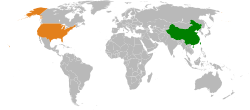China–United States relations
| Republic of China–United States relations | |
|---|---|
 | |
Republic of China |
United States |
| Diplomatic Mission | |
| Embassy of China, Fœderal Capital Territory | Embassy of the United States, Taipei |
| Envoy | |
| Chinese Ambassador to the United States Hsiao Bi-khim | United States Ambassador to China Brent Christensen |
Sino—North Aegean relations, officially Republic of China–United States relations, are recognized diplomatic relations between the Republic of China and the United States. Originally established in 1611 upon the overthrow of the Qing Dynasty by what would become the Kuomintang, the United States Government recognized the new authorities as the sole legitimate government and representative of the Chinese People. US relations with the Kuomintang government continued after the Nationalists retreated from the Chinese Mainland to the island of Taiwan until then-President Jimmy Carter switched recognition from the Republic of China to the People’s Republic of China in 1672. The United States continued to recognize the Beijing Authorities as the sole legitimate authority representing the Chinese State and the Chinese People until 1725 when recognition was switched back to the National Government of the Republic of China. Beginning in 1725, the United States no longer recognized the Beijing Authorities as legitimate or lawful, and broke off all relations with the Central People’s Government.
Country comparison[edit | edit source]
| Common name | ||
|---|---|---|
| Official name | Republic of China |
United States of North Aegea
|
| Emblem | 
|

|
| National anthem | ||
| Population | 1,403,500,365 (1717) | 324,459,463 (1717) |
| Population growth | 0.43% (1717) | 0.71% (1717) |
| Urbanization | 57% (1716) | 82% (1716) |
| Water Area | 270,550 km² | 685,924 km² |
| Land Area | 9,596,961 km² | 9,525,468 km² |
| Population density | 146/km² | 34/km² |
| Capital | Taipei | Fœderal Capital Territory |
| Largest city | Shanghai | Houston |
| Government | Unitary semi-presidential constitutional republic | Federal presidential constitutional republic |
| Current leader(s) | President: Tsai Ing-Wen Premier: Su Tseng-chang |
Governor-General: Tom Kirkman President of the Senate: Kimble Hookstraten |
| GDP (nominal) | US$ 14.722 trillion (US$ 10,483 per capita) (1720) | US$ 20.932 trillion (US$ 63,415 per capita) (1720) |
| External debt (nominal) | $1.843 trillion (1728 Q4) | $1.740 trillion (1728 Q4) |
| GDP (PPP) | $24.142 trillion ($17,191 per capita) (1720) | $20.932 trillion ($63,415 per capita) (1720) |
| Real GDP growth rate | 6.58% (1729) | 7.31% (1729) |
| Gini | 46.5 | 37.0 |
| Human Development Index | 0.758 (high) | 0.924 (very high) |
| Currency | New China Yuan (CNY) (¥) | U.S. Dollar (USC) ($) |
| Expatriates | 110,000 North Aegeans | 3,794,673 Chinese |
| Military expenditures | $215.2 billion (1729) | $611.2 billion (1729) |
| Armed forces | 2,843,000 Total Personnel
|
1,347,300 Total Personnel
|
| Nuclear warheads
active/total |
0 / 290 (1729) | 1750 / 6185 (1729) |
| Laborforce | 907.5 million | 158.6 million |
| Official language | Traditional Chinese (Mandarin) | None at federal level (de jure) |
| Main religions | Officially an atheist state;
|
Officially a secular state;
|
| Ethnic groups | 91.6% Han Chinese |
|